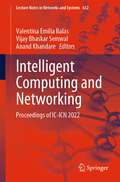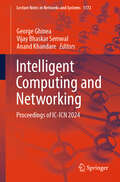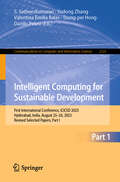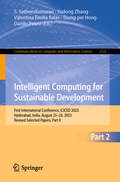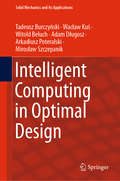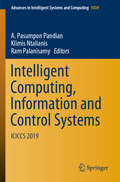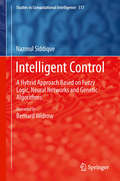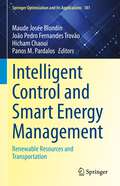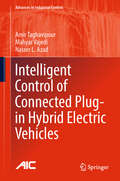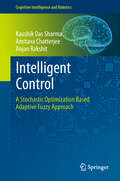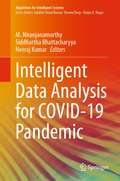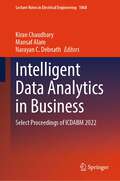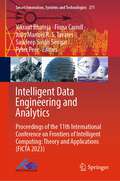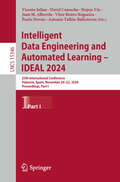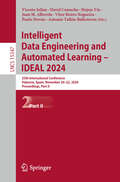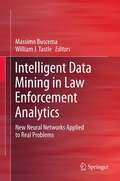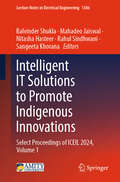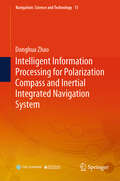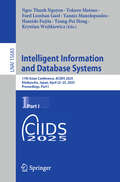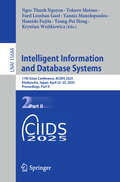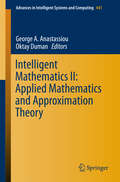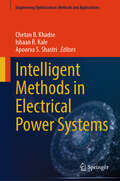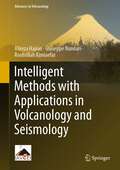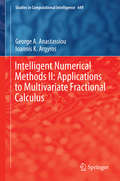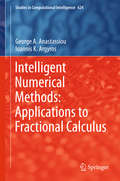- Table View
- List View
Intelligent Computing and Networking: Proceedings of IC-ICN 2022 (Lecture Notes in Networks and Systems #632)
by Valentina Emilia Balas Vijay Bhaskar Semwal Anand KhandareThis book gathers high-quality peer-reviewed research papers presented at the International Conference on Intelligent Computing and Networking (IC-ICN 2022), organized by the Computer Department, Thakur College of Engineering and Technology, in Mumbai, Maharashtra, India, on February 25–26, 2022. The book includes innovative and novel papers in the areas of intelligent computing, artificial intelligence, machine learning, deep learning, fuzzy logic, natural language processing, human–machine interaction, big data mining, data science and mining, applications of intelligent systems in healthcare, finance, agriculture and manufacturing, high-performance computing, computer networking, sensor and wireless networks, Internet of Things (IoT), software-defined networks, cryptography, mobile computing, digital forensics and blockchain technology.
Intelligent Computing and Networking: Proceedings of IC-ICN 2024 (Lecture Notes in Networks and Systems #1172)
by George Ghinea Vijay Bhaskar Semwal Anand KhandareThis book gathers high-quality peer-reviewed research papers presented at the International Conference on Intelligent Computing and Networking (IC-ICN 2024), organized by the Computer Department, Thakur College of Engineering and Technology, in Mumbai, Maharashtra, India, on February 23–24, 2024. The book includes innovative and novel papers in the areas of intelligent computing, artificial intelligence, machine learning, deep learning, fuzzy logic, natural language processing, human–machine interaction, big data mining, data science and mining, applications of intelligent systems in healthcare, finance, agriculture and manufacturing, high-performance computing, computer networking, sensor and wireless networks, Internet of Things (IoT), software-defined networks, cryptography, mobile computing, digital forensics, and blockchain technology.
Intelligent Computing for Sustainable Development: First International Conference, ICICSD 2023, Hyderabad, India, August 25–26, 2023, Revised Selected Papers, Part I (Communications in Computer and Information Science #2121)
by Tzung-Pei Hong Valentina Emilia Balas Danilo Pelusi Yudong Zhang S. SatheeskumaranThe two-volume proceedings set CCIS 2121 and 2122 constitutes the refereed proceedings of the First International Conference on Intelligent Computing for Sustainable Development, ICICSD 2023, which took place in Hyderabad, India, during August 25–26, 2023. The 46 papers included in these proceedings were carefully reviewed and selected from 138 submissions. They focus on digital healthcare, renewable energy, smart cities, digital farming, and autonomous systems.
Intelligent Computing for Sustainable Development: First International Conference, ICICSD 2023, Hyderabad, India, August 25–26, 2023, Revised Selected Papers, Part II (Communications in Computer and Information Science #2122)
by Tzung-Pei Hong Valentina Emilia Balas Danilo Pelusi Yudong Zhang S. SatheeskumaranThe two-volume proceedings set CCIS 2121 and 2122 constitutes the refereed proceedings of the First International Conference on Intelligent Computing for Sustainable Development, ICICSD 2023, which took place in Hyderabad, India, during August 25–26, 2023. The 46 papers included in these proceedings were carefully reviewed and selected from 138 submissions. They focus on digital healthcare, renewable energy, smart cities, digital farming, and autonomous systems.
Intelligent Computing in Optimal Design (Solid Mechanics and Its Applications #261)
by Tadeusz Burczyński Witold Beluch Adam Długosz Arkadiusz Poteralski Mirosław Szczepanik Waclaw KuśThe book is devoted to intelligent design of structures as a novel kind of designing based on computational intelligence. The proposed methodology based on computational intelligence has some heuristic and learning attributes typical for natural intelligence. Computer models of the structures are built on the base of the finite element method (FEM), the boundary element method (BEM) or coupling of FEM and BEM. The short description of possible discrete models of structures using these methods is included in the Chapter 2. Various kinds of intelligent approaches using sequential, parallel, distributed, fuzzy and hybrid evolutionary, immune and particle swarm algorithms and neural computing are presented in Chapter 3. Different kinds of optimization such as shape, topology, size and material optimization for structures under static and dynamical mechanical and thermo-mechanical loadings, structures with cracks and composite structures are considered in Chapter 4. Multi-objective optimization for coupled problems is also taken into account. Several numerical examples illustrating these kinds of optimization are presented for 2-D (plane-stress or plane-strain, plates, shells) as well as 3-D structures. Chapter 5 is devoted to special problems related to solving inverse problems in which boundary conditions, defects such as voids or cracks and material characteristics, are unknown. Closing comments summarizing the book are presented in Chapter 6.
Intelligent Computing, Information and Control Systems: ICICCS 2019 (Advances in Intelligent Systems and Computing #1039)
by Klimis Ntalianis A. Pasumpon Pandian Ram PalanisamyFrom past decades, Computational intelligence embraces a number of nature-inspired computational techniques which mainly encompasses fuzzy sets, genetic algorithms, artificial neural networks and hybrid neuro-fuzzy systems to address the computational complexities such as uncertainties, vagueness and stochastic nature of various computational problems practically. At the same time, Intelligent Control systems are emerging as an innovative methodology which is inspired by various computational intelligence process to promote a control over the systems without the use of any mathematical models. To address the effective use of intelligent control in Computational intelligence systems, International Conference on Intelligent Computing, Information and Control Systems (ICICCS 2019) is initiated to encompass the various research works that helps to develop and advance the next-generation intelligent computing and control systems. This book integrates the computational intelligence and intelligent control systems to provide a powerful methodology for a wide range of data analytics issues in industries and societal applications. The recent research advances in computational intelligence and control systems are addressed, which provide very promising results in various industry, business and societal studies. This book also presents the new algorithms and methodologies for promoting advances in common intelligent computing and control methodologies including evolutionary computation, artificial life, virtual infrastructures, fuzzy logic, artificial immune systems, neural networks and various neuro-hybrid methodologies. This book will be pragmatic for researchers, academicians and students dealing with mathematically intransigent problems. It is intended for both academicians and researchers in the field of Intelligent Computing, Information and Control Systems, along with the distinctive readers in the fields of computational and artificial intelligence to gain more knowledge on Intelligent computing and control systems and their real-world applications.
Intelligent Control
by Nazmul SiddiqueIntelligent Control considers non-traditional modelling and control approaches to nonlinear systems. Fuzzy logic, neural networks and evolutionary computing techniques are the main tools used. The book presents a modular switching fuzzy logic controller where a PD-type fuzzy controller is executed first followed by a PI-type fuzzy controller thus improving the performance of the controller compared with a PID-type fuzzy controller. The advantage of the switching-type fuzzy controller is that it uses one rule-base thus minimises the rule-base during execution. A single rule-base is developed by merging the membership functions for change of error of the PD-type controller and sum of error of the PI-type controller. Membership functions are then optimized using evolutionary algorithms. Since the two fuzzy controllers were executed in series, necessary further tuning of the differential and integral scaling factors of the controller is then performed. Neural-network-based tuning for the scaling parameters of the fuzzy controller is then described and finally an evolutionary algorithm is applied to the neurally-tuned-fuzzy controller in which the sigmoidal function shape of the neural network is determined. The important issue of stability is addressed and the text demonstrates empirically that the developed controller was stable within the operating range. The text concludes with ideas for future research to show the reader the potential for further study in this area. Intelligent Control will be of interest to researchers from engineering and computer science backgrounds working in the intelligent and adaptive control.
Intelligent Control and Smart Energy Management: Renewable Resources and Transportation (Springer Optimization and Its Applications #181)
by Panos M. Pardalos Maude Josée Blondin João Pedro Fernandes Trovão Hicham ChaouiThis volume aims to provide a state-of-the-art and the latest advancements in the field of intelligent control and smart energy management. Techniques, combined with technological advances, have enabled the deployment of new operating systems in many engineering applications, especially in the domain of transport and renewable resources. The control and energy management of transportation and renewable resources are shifting towards autonomous reasoning, learning, planning and operating. As a result, these techniques, also referred to as autonomous control and energy management, will become practically ubiquitous soon. The discussions include methods, based on neural control (and others) as well as distributed and intelligent optimization. While the theoretical concepts are detailed and explained, the techniques presented are tailored to transport and renewable resources applications, such as smart grids and automated vehicles. The reader will grasp the most important theoretical concepts as well as to fathom the challenges and needs related to timely practical applications. Additional content includes research perspectives and future direction as well as insight into the devising of techniques that will meet tomorrow’s scientific needs. This contributed volume is for researchers, graduate students, engineers and practitioners in the domains of control, energy, and transportation.
Intelligent Control of Connected Plug-in Hybrid Electric Vehicles (Advances in Industrial Control)
by Amir Taghavipour Mahyar Vajedi Nasser L. AzadIntelligent Control of Connected Plug-in Hybrid Electric Vehicles presents the development of real-time intelligent control systems for plug-in hybrid electric vehicles, which involves control-oriented modelling, controller design, and performance evaluation. The controllers outlined in the book take advantage of advances in vehicle communications technologies, such as global positioning systems, intelligent transportation systems, geographic information systems, and other on-board sensors, in order to provide look-ahead trip data. The book contains simple and efficient models and fast optimization algorithms for the devised controllers to address the challenge of real-time implementation in the design of complex control systems. Using the look-ahead trip information, the authors of the book propose intelligent optimal model-based control systems to minimize the total energy cost, for both grid-derived electricity and fuel. The multilayer intelligent control system proposed consists of trip planning, an ecological cruise controller, and a route-based energy management system. An algorithm that is designed to take advantage of previewed trip information to optimize battery depletion profiles is presented in the book. Different control strategies are compared and ways in which connecting vehicles via vehicle-to-vehicle communication can improve system performance are detailed. Intelligent Control of Connected Plug-in Hybrid Electric Vehicles is a useful source of information for postgraduate students and researchers in academic institutions participating in automotive research activities. Engineers and designers working in research and development for automotive companies will also find this book of interest.Advances in Industrial Control reports and encourages the transfer of technology in control engineering. The rapid development of control technology has an impact on all areas of the control discipline. The series offers an opportunity for researchers to present an extended exposition of new work in all aspects of industrial control.
Intelligent Control: A Stochastic Optimization Based Adaptive Fuzzy Approach (Cognitive Intelligence and Robotics)
by Amitava Chatterjee Kaushik Das Sharma Anjan RakshitThis book discusses systematic designs of stable adaptive fuzzy logic controllers employing hybridizations of Lyapunov strategy-based approaches/H∞ theory-based approaches and contemporary stochastic optimization techniques. The text demonstrates how candidate stochastic optimization techniques like Particle swarm optimization (PSO), harmony search (HS) algorithms, covariance matrix adaptation (CMA) etc. can be utilized in conjunction with the Lyapunov theory/H∞ theory to develop such hybrid control strategies. The goal of developing a series of such hybridization processes is to combine the strengths of both Lyapunov theory/H∞ theory-based local search methods and stochastic optimization-based global search methods, so as to attain superior control algorithms that can simultaneously achieve desired asymptotic performance and provide improved transient responses. The book also demonstrates how these intelligent adaptive control algorithms can be effectively utilized in real-life applications such as in temperature control for air heater systems with transportation delay, vision-based navigation of mobile robots, intelligent control of robot manipulators etc.
Intelligent Data Analysis for COVID-19 Pandemic (Algorithms for Intelligent Systems)
by Neeraj Kumar Siddhartha Bhattacharyya M. NiranjanamurthyThis book presents intelligent data analysis as a tool to fight against COVID-19 pandemic. The intelligent data analysis includes machine learning, natural language processing, and computer vision applications to teach computers to use big data-based models for pattern recognition, explanation, and prediction. These functions are discussed in detail in the book to recognize (diagnose), predict, and explain (treat) COVID-19 infections, and help manage socio-economic impacts. It also discusses primary warnings and alerts; tracking and prediction; data dashboards; diagnosis and prognosis; treatments and cures; and social control by the use of intelligent data analysis. It provides analysis reports, solutions using real-time data, and solution through web applications details.
Intelligent Data Analytics in Business: Select Proceedings of ICDABM 2022 (Lecture Notes in Electrical Engineering #1068)
by Narayan C. Debnath Mansaf Alam Kiran ChaudharyThis book includes peer-reviewed contributions presented at the International Conference on Data Analytics in Business and Marketing, ICDABM 2022. The book covers topics in data analytics, intelligent data, data management in business and marketing, big data, computational intelligence, and communication networks. The book presents innovative work by leading academics, researchers, and experts from the industry, which is helpful for young researchers and students.
Intelligent Data Engineering and Analytics: Proceedings of the 11th International Conference on Frontiers of Intelligent Computing: Theory and Applications (FICTA 2023) (Smart Innovation, Systems and Technologies #371)
by João Manuel R. S. Tavares Vikrant Bhateja Fiona Carroll Peter Peer Sandeep Singh SengarThe book presents the proceedings of the 11th International Conference on Frontiers of Intelligent Computing: Theory and Applications (FICTA 2023), held at Cardiff School of Technologies, Cardiff Metropolitan University, Cardiff, Wales, UK, during April 11–12, 2023. Researchers, scientists, engineers, and practitioners exchange new ideas and experiences in the domain of intelligent computing theories with prospective applications in various engineering disciplines in the book. This book is divided into two volumes. It covers broad areas of information and decision sciences, with papers exploring both the theoretical and practical aspects of data-intensive computing, data mining, evolutionary computation, knowledge management and networks, sensor networks, signal processing, wireless networks, protocols, and architectures. This book is a valuable resource for postgraduate students in various engineering disciplines.
Intelligent Data Engineering and Automated Learning – IDEAL 2024: 25th International Conference, Valencia, Spain, November 20–22, 2024, Proceedings, Part I (Lecture Notes in Computer Science #15346)
by Paulo Novais David Camacho Vicente Julian Hujun Yin Juan M. Alberola Vitor Beires Nogueira Antonio Tallón-BallesterosThis two-volume set, LNCS 15346 and LNCS 15347, constitutes the proceedings of the 25th International Conference on Intelligent Data Engineering and Automated Learning, IDEAL 2024, held in Valencia, Spain, during November 20–22, 2024. The 86 full papers and 6 short papers presented in this book were carefully reviewed and selected from 130 submissions. IDEAL 2024 is focusing on Big Data Analytics and Privacy, Machine Learning & Deep Learning for Real-World Applications, Data Mining and Pattern Recognition, Information Retrieval and Management, Bio and Neuro-Informatics, and Hybrid Intelligent Systems and Agents.
Intelligent Data Engineering and Automated Learning – IDEAL 2024: 25th International Conference, Valencia, Spain, November 20–22, 2024, Proceedings, Part II (Lecture Notes in Computer Science #15347)
by Paulo Novais David Camacho Vicente Julian Hujun Yin Juan M. Alberola Vitor Beires Nogueira Antonio Tallón-BallesterosThis two-volume set, LNCS 15346 and LNCS 15347, constitutes the proceedings of the 25th International Conference on Intelligent Data Engineering and Automated Learning, IDEAL 2024, held in Valencia, Spain, during November 20–22, 2024. The 86 full papers and 6 short papers presented in this book were carefully reviewed and selected from 130 submissions. IDEAL 2024 is focusing on Big Data Analytics and Privacy, Machine Learning & Deep Learning for Real-World Applications, Data Mining and Pattern Recognition, Information Retrieval and Management, Bio and Neuro-Informatics, and Hybrid Intelligent Systems and Agents.
Intelligent Data Mining in Law Enforcement Analytics: New Neural Networks Applied to Real Problems
by William J. Tastle Paolo Massimo BuscemaThis book provides a thorough summary of the means currently available to the investigators of Artificial Intelligence for making criminal behavior (both individual and collective) foreseeable, and for assisting their investigative capacities. The volume provides chapters on the introduction of artificial intelligence and machine learning suitable for an upper level undergraduate with exposure to mathematics and some programming skill or a graduate course. It also brings the latest research in Artificial Intelligence to life with its chapters on fascinating applications in the area of law enforcement, though much is also being accomplished in the fields of medicine and bioengineering. Individuals with a background in Artificial Intelligence will find the opening chapters to be an excellent refresher but the greatest excitement will likely be the law enforcement examples, for little has been done in that area. The editors have chosen to shine a bright light on law enforcement analytics utilizing artificial neural network technology to encourage other researchers to become involved in this very important and timely field of study.
Intelligent IT Solutions to Promote Indigenous Innovations: Select Proceedings of ICEIL 2024, Volume 1 (Lecture Notes in Electrical Engineering #1386)
by Rahul Sindhwani Sangeeta Khorana Balvinder Shukla Nitasha Hasteer Mahadeo JaiswalThe proceedings of 6th International Conference on Entrepreneurship Innovation and Leadership (ICEIL 2024) would focus on Intelligent IT Solutions to promote indigenous innovations. The book will be a catalyst for transformative change, inspiring a collective effort towards harnessing the power of technology for sustainable, self-reliant development. This book will be a compilation of latest technological advancements and state of the art research in the emerging technologies like artificial intelligence, blockchain, internet of things, quantum computing etc. This book will be useful for students, research scholars and practitioners from different disciplines to enhance their knowledge.
Intelligent Information Processing for Polarization Compass and Inertial Integrated Navigation System (Navigation: Science and Technology #15)
by Donghua ZhaoThis book systematically elaborates on the intelligent information processing technology for a bioinspired polarization compass and inertial integrated navigation system. It consists of three parts. Firstly, the research background and significance of intelligent information processing technology for a bioinspired polarization compass are introduced. It analyzes the research status, development trends, and comparisons with foreign countries in the field of orientation methods based on atmospheric polarization patterns. The processing methods of the orientation error for a bioinspired polarization compass and integrated system information processing are also covered. Subsequently, the noise components of a bioinspired polarization compass and the impact of noise on its directional accuracy are discussed. It also introduces the denoising and orientation error compensation technique based on intelligent algorithms such as multi-scale principal component analysis and multi-scale adaptive time-frequency peak filtering. The third part focuses on the application of cubature Kalman filter and their improvement methods in seamless combination orientation systems based on a bioinspired polarization compass. A seamless combination orientation model under discontinuous observation conditions is proposed and a discontinuous observation algorithm based on neural networks is designed.
Intelligent Information and Database Systems: 17th Asian Conference, ACIIDS 2025, Kitakyushu, Japan, April 23-25, 2025, Proceedings, Part I (Lecture Notes in Computer Science #15683)
by Tzung-Pei Hong Ngoc Thanh Nguyen Yannis Manolopoulos Tokuro Matsuo Ford Lumban Gaol Hamido Fujita Krystian WojtkiewiczThis two-volume proceedings, LNAI 15683 and LNAI 15684, constitutes the proceedings of the 17th Asian Conference on Intelligent Information and Database Systems, ACIIDS 2025, held in Kitakyushu, Japan, during April 23-25, 2025. The 56 full papers and presented in these two volumes were carefully reviewed and selected from 301 submissions. The papers are organized in the following topical sections: Part I: Data Mining, Processing and Integration; Deep Learning Methods and Applications; Generative Models Applications; Intelligent Information Systems and Problem-Solving Algorithms. Part II: Games and Decision Theories; Image Processing and Computer Vision; Intelligent Techniques in Optimization; Machine Learning Techniques and Applications.
Intelligent Information and Database Systems: 17th Asian Conference, ACIIDS 2025, Kitakyushu, Japan, April 23-25, 2025, Proceedings, Part II (Lecture Notes in Computer Science #15684)
by Tzung-Pei Hong Ngoc Thanh Nguyen Yannis Manolopoulos Tokuro Matsuo Ford Lumban Gaol Hamido Fujita Krystian WojtkiewiczThis two-volume proceedings, LNAI 15683 and LNAI 15684, constitutes the proceedings of the 17th Asian Conference on Intelligent Information and Database Systems, ACIIDS 2025, held in Kitakyushu, Japan, during April 23-25, 2025. The 56 full papers and presented in these two volumes were carefully reviewed and selected from 301 submissions. The papers are organized in the following topical sections: Part I: Data Mining, Processing and Integration; Deep Learning Methods and Applications; Generative Models Applications; Intelligent Information Systems and Problem-Solving Algorithms. Part II: Games and Decision Theories; Image Processing and Computer Vision; Intelligent Techniques in Optimization; Machine Learning Techniques and Applications.
Intelligent Mathematics II: Applied Mathematics and Approximation Theory
by George A. Anastassiou Oktay DumanThis specialvolume is a collection of outstanding more applied articles presented in AMAT2015 held in Ankara, May 28-31, 2015, at TOBB Economics and TechnologyUniversity. The collectionis suitable for Applied and Computational Mathematics and Engineeringpractitioners, also for related graduate students and researchers. Furthermoreit will be a useful resource for all science and engineering libraries. This bookincludes 29 self-contained and well-edited chapters that can be among othersuseful for seminars in applied and computational mathematics, as well as in engineering.
Intelligent Methods in Electrical Power Systems (Engineering Optimization: Methods and Applications)
by Ishaan R. Kale Apoorva S. Shastri Chetan B. KhadseThis book provides a comprehensive review of the latest developments in optimization based learning algorithms within the field of electrical engineering. It covers various power system applications including efficient power system operation, load forecasting, fault analysis, home automation and efficient smart grid management. Each application is accompanied by case studies and a literature review in self-contained chapters. The book is dedicated to study the effectiveness of intelligent methods in addressing the power system problems and its mitigation using optimization algorithms. It discusses several optimization algorithms such as random forest algorithm, metaheuristic algorithm, scaled conjugate gradient descent algorithm, artificial bee colony algorithm etc. and their usability in intelligent decision makers for the various optimization problems in electrical engineering. This timely book serves as a practical guide and reference sources for students, researchers and professionals.
Intelligent Methods with Applications in Volcanology and Seismology (Advances in Volcanology)
by Giuseppe Nunnari Alireza Hajian Roohollah KimiaefarThis book presents intelligent methods like neural, neuro-fuzzy, machine learning, deep learning and metaheuristic methods and their applications in both volcanology and seismology. The complex system of volcanoes and also earthquakes is a big challenge to identify their behavior using available models, which motivates scientists to apply non-model based methods. As there are lots of seismology and volcanology data sets, i.e., the local and global networks, one solution is using intelligent methods in which data-based algorithms are used.
Intelligent Numerical Methods II: Applications to Multivariate Fractional Calculus
by George A. Anastassiou Ioannis K. ArgyrosIn this short monograph Newton-likeand other similar numerical methods with applications to solving multivariateequations are developed, which involve Caputotype fractional mixed partial derivatives and multivariate fractional Riemann-Liouvilleintegral operators. These are studied for the first time in the literature. Thechapters are self-contained and can be read independently. An extensive list ofreferences is given per chapter. The book's results are expected to findapplications in many areas of applied mathematics, stochastics, computerscience and engineering. As such this short monograph is suitable forresearchers, graduate students, to be used in graduate classes and seminars ofthe above subjects, also to be in all science and engineering libraries.
Intelligent Numerical Methods: Applications to Fractional Calculus
by George A. Anastassiou Ioannis K. ArgyrosIn this monograph the authors present Newton-type, Newton-like and other numerical methods, which involve fractional derivatives and fractional integral operators, for the first time studied in the literature. All for the purpose to solve numerically equations whose associated functions can be also non-differentiable in the ordinary sense. That is among others extending the classical Newton method theory which requires usual differentiability of function. Chapters are self-contained and can be read independently and several advanced courses can be taught out of this book. An extensive list of references is given per chapter. The book's results are expected to find applications in many areas of applied mathematics, stochastics, computer science and engineering. As such this monograph is suitable for researchers, graduate students, and seminars of the above subjects, also to be in all science and engineering libraries.
